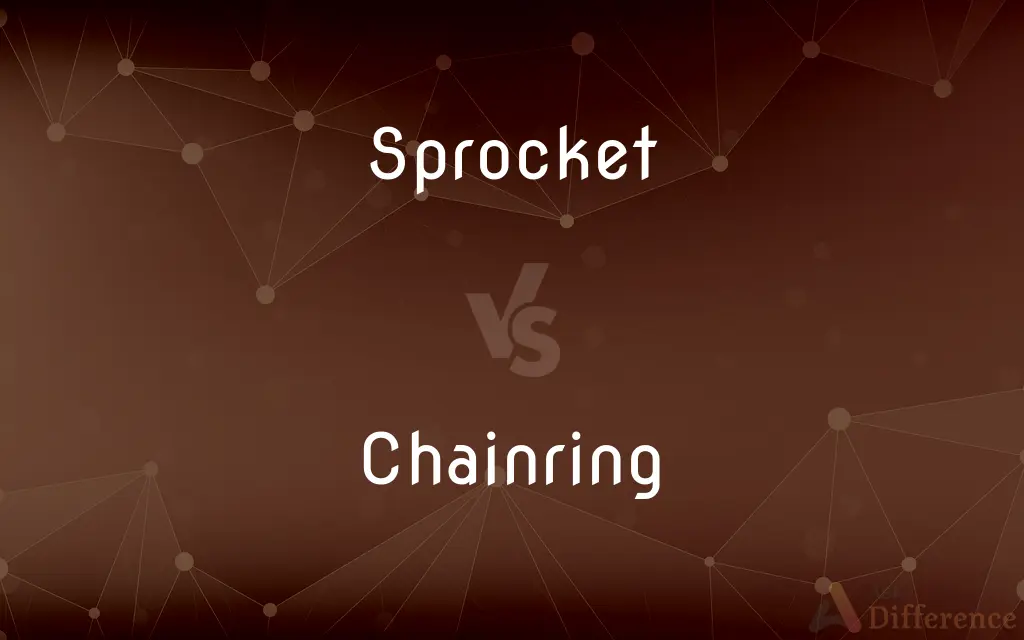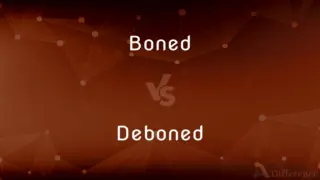Sprocket vs. Chainring — What's the Difference?
Edited by Tayyaba Rehman — By Urooj Arif — Updated on April 6, 2024
A sprocket engages a chain to transfer motion, while a chainring, part of a bicycle's crankset, propels the bike when pedaled.

Difference Between Sprocket and Chainring
Table of Contents
ADVERTISEMENT
Key Differences
Sprockets and chainrings are both integral components in the mechanism of a bicycle, transferring pedal power into motion. Sprockets, however, are found in various machinery and vehicles beyond bicycles, engaging with chains to transmit rotary motion. Chainrings, on the other hand, are specifically part of a bicycle's crankset, directly interacting with the cyclist's pedaling action to drive the chain.
While sprockets can vary widely in size and tooth count depending on their application, from small devices to large industrial machinery, chainrings are typically sized to match the specific needs of bicycling, affecting the bicycle's gearing ratio and pedaling ease. This variance allows sprockets to be customized for the specific torque or speed requirements of different machinery, whereas chainrings are optimized for human biomechanics and cycling efficiency.
The material composition of sprockets can range depending on their use, from hardened steel for industrial applications to lightweight alloys for vehicles. Chainrings, conversely, are generally made from materials that offer a balance between durability and weight, such as aluminum or carbon fiber, to suit cycling performance needs.
In terms of maintenance and wear, sprockets may have different lifespans and wear characteristics based on their usage environment. High-torque industrial sprockets might require robust materials and frequent maintenance. Chainrings are subjected to constant human force and environmental conditions like mud and rain, necessitating regular checks for wear and alignment for optimal performance.
The design of a sprocket is influenced by its specific application, with some designed to work under high stress or in precise timing applications. Chainrings, while also designed for efficiency, focus more on compatibility with different chain sizes and the ergonomic requirements of cycling, such as smooth shifting and minimizing fatigue over long distances.
ADVERTISEMENT
Comparison Chart
Application
Used in various machinery and vehicles to transfer motion.
Specifically used in bicycles as part of the crankset.
Size and Teeth
Varies widely for specific torque or speed requirements.
Optimized for cycling, affecting gearing ratio.
Material
Can range from hardened steel to lightweight alloys.
Usually aluminum or carbon fiber for performance.
Maintenance
Depends on environment; may require robust materials.
Regular checks for wear and alignment needed.
Design Focus
Customized for specific machinery requirements.
Focuses on compatibility and cycling efficiency.
Compare with Definitions
Sprocket
Sprockets are critical for transmitting rotary motion in many mechanical systems.
Each sprocket's design is optimized for its specific function in the machine.
Chainring
Specifically designed for bicycles, influencing gear ratios.
A larger chainring requires more force to pedal but increases speed.
Sprocket
A wheel with teeth or cogs designed to engage with a chain.
The motor's sprocket connects to the chain, transferring power efficiently.
Chainring
Essential for the bicycle's gear system, affecting ride quality.
Upgrading the chainring can significantly improve the bike's performance.
Sprocket
Found in various machines, from bicycles to industrial conveyors.
The conveyor's sprocket ensures smooth operation by engaging the chain precisely.
Chainring
Needs regular maintenance to ensure optimal functionality.
Checking the chainring for wear helps maintain efficient power transfer.
Sprocket
Requires maintenance based on the operating environment.
Regular lubrication extends the sprocket's lifespan and performance.
Chainring
A large sprocket attached to a bike's crankset, interfacing with the chain.
The chainring converts the cyclist's pedaling force into forward motion.
Sprocket
Can be made from a range of materials for specific applications.
The high-strength steel sprocket is ideal for heavy-duty machinery.
Chainring
Usually made from lightweight materials like aluminum for efficiency.
The carbon fiber chainring offers a superior strength-to-weight ratio.
Sprocket
A sprocket, sprocket-wheel or chainwheel is a profiled wheel with teeth that mesh with a chain, track or other perforated or indented material. The name 'sprocket' applies generally to any wheel upon which radial projections engage a chain passing over it.
Chainring
The large forward ring on a bicycle that a chain attaches to, in order to transfer energy to a wheel. It consists of one or more sprockets that are driven by the cranks and pedals of the bicycle.
Sprocket
Any of various toothlike projections arranged on a wheel rim to engage the links of a chain.
Sprocket
A wheel having such teeth along its rim. Also called sprocket wheel.
Sprocket
A cylinder with a toothed rim that engages in the perforations of photographic or movie film to pull it through a camera or projector.
Sprocket
(mechanical engineering) A toothed wheel that enmeshes with a chain or other perforated band.
Sprocket
The tooth of such a wheel.
Sprocket
(architecture) A flared extension at the base of a sloped roof.
Sprocket
A placeholder name for an unnamed, unspecified, or hypothetical manufactured good or product.
Suppose we have a widget factory that produces 100 widgets per year, and a sprocket factory that produces 200 sprockets per year.
Sprocket
A tooth or projection, as on the periphery of a wheel, shaped so as to engage with a chain.
Sprocket
Roller that has teeth on the rims to pull film or paper through
Sprocket
Thin wheel with teeth that engage with a chain
Sprocket
Tooth on the rim of gear wheel
Common Curiosities
What is a sprocket?
A sprocket is a toothed wheel designed to engage a chain, transferring rotary motion in machinery and vehicles.
Why are chainrings optimized for cycling?
Chainrings are optimized for cycling to match human biomechanics, enhancing efficiency and reducing fatigue.
How do sprockets differ in application from chainrings?
Sprockets are used in a wide range of machinery for motion transfer, while chainrings are specifically for bicycles.
What is a chainring?
A chainring is a specific type of sprocket attached to a bicycle's crankset, converting pedaling action into movement.
Do chainrings come in different sizes?
Yes, chainrings vary in size to influence the bicycle's gearing ratio and pedaling dynamics.
Can a worn sprocket affect machinery operation?
Absolutely, a worn sprocket can lead to inefficient motion transfer and potential damage to the machinery.
How do sprocket sizes impact machinery performance?
Sprocket size affects the torque and speed of the machinery, with larger sprockets providing more torque but less speed.
How does a chainring affect a bicycle's speed?
The size and design of a chainring can significantly impact a bicycle's speed by altering the gearing ratio and pedaling efficiency.
Are sprockets interchangeable between different machines?
While some sprockets may fit various machines, they are typically designed for specific applications and loads.
Is it easy to replace a chainring?
Replacing a chainring can be straightforward with the right tools and knowledge but might require professional help for optimal alignment.
Can the material of a sprocket affect its performance?
Yes, the material can significantly impact a sprocket's durability, weight, and suitability for its intended use.
What materials are commonly used to make chainrings?
Chainrings are often made from aluminum or carbon fiber, balancing durability and weight for cycling performance.
How often should a chainring be maintained?
Regular maintenance is crucial to ensure the chainring performs well and lasts longer, depending on usage and conditions.
What is the primary purpose of a sprocket in a bicycle?
In bicycles, sprockets are part of the drivetrain, facilitating the transfer of pedal power into forward motion.
What maintenance does a sprocket require?
Sprocket maintenance can include regular cleaning, lubrication, and inspection for wear to ensure efficient operation.
Share Your Discovery

Previous Comparison
Boned vs. Deboned
Next Comparison
Portal vs. VortalAuthor Spotlight
Written by
Urooj ArifUrooj is a skilled content writer at Ask Difference, known for her exceptional ability to simplify complex topics into engaging and informative content. With a passion for research and a flair for clear, concise writing, she consistently delivers articles that resonate with our diverse audience.
Edited by
Tayyaba RehmanTayyaba Rehman is a distinguished writer, currently serving as a primary contributor to askdifference.com. As a researcher in semantics and etymology, Tayyaba's passion for the complexity of languages and their distinctions has found a perfect home on the platform. Tayyaba delves into the intricacies of language, distinguishing between commonly confused words and phrases, thereby providing clarity for readers worldwide.














































